A New Dynamic Modeling Approach to Predict Microbial Methane Generation and Consumption in Marine Sediments
Abstract
:1. Introduction
2. Materials and Methods
2.1. Data Source
2.2. Numerical Modeling
3. Results and Discussion
3.1. Solid Phase and Pore Water Concentration
3.2. Methane Phase Behavior
3.3. Carbon Sink
3.4. Sedimentation Rate and Initial Age of POC
3.5. Coexistence of Free Gas and Gas Hydrate in GHSZ
4. Conclusions
Supplementary Materials
Author Contributions
Funding
Data Availability Statement
Acknowledgments
Conflicts of Interest
Appendix A
| Parameter | Equation |
|---|---|
| Porosity | |
| Burial velocity of solids | |
| Burial velocity of pore water | |
| Relative velocity of free gas | |
| Factor converting Cs (wt%) in Cl (mM) | |
| Molecular diffusion in sediments | |
| Factor converting wt% in vol% |
| Reaction | Rate Expression |
|---|---|
| POC degradation | |
| Sulfate reduction | |
| Methanogenesis | |
| Anaerobic oxidation of methane | |
| Calcium carbonate precipitation (if ) | |
| Calcium carbonate dissolution (if ) | |
| Magnesium carbonate precipitation (if ) | |
| Magnesium carbonate dissolution (if ) | |
| Hydrate formation (if ) | |
| Hydrate dissociation (if ) | |
| Free gas formation (if ) | |
| Free gas dissociation (if ) |
| Species | Rates |
|---|---|
| Particulate organic carbon (POC) | |
| Sulfate (SO42−) | |
| Methane (CH4) | |
| Dissolved inorganic carbon (DIC) | |
| Calcium (Ca2+) | |
| Magnesium (Mg2+) | |
| Calcium carbonate (CaCO3) | |
| Magnesium carbonate (MgCO3) | |
| Gas hydrate | |
| Free gas |
| Parameter | Units | Site 997 |
|---|---|---|
| Initial age of POC () | yr | 8 × 10−5 |
| Monod constant of POC degradation () | mM | 68 |
| Monod constant of sulfate reduction () | mM | 1 |
| Kinetic constant of AOM () | L yr−1 mmol−1 | 0.05 |
| Kinetic constant of calcium carbonate precipitation () | yr−1 wt%−1 | 10−8 |
| Kinetic constant of calcium carbonate dissolution () | yr−1 | 10−8 |
| Kinetic constant of magnesium carbonate precipitation () | yr−1 wt%−1 | 10−10 |
| Kinetic constant of magnesium carbonate dissolution () | yr−1 | 10−10 |
| Kinetic constant of hydrate formation () | yr−1 wt%−1 | 0.02 |
| Kinetic constant of hydrate dissociation () | yr−1 | 0.02 |
| Kinetic constant of free gas formation () | mM yr−1 | 20 |
| Kinetic constant of free gas dissolution () | yr−1 | 0.0002 |
| Porosity at depth zero () | – | 0.75 |
| Porosity at infinite depth () | – | 0.47 |
| Attenuation coefficient () | – | 0.00323 |
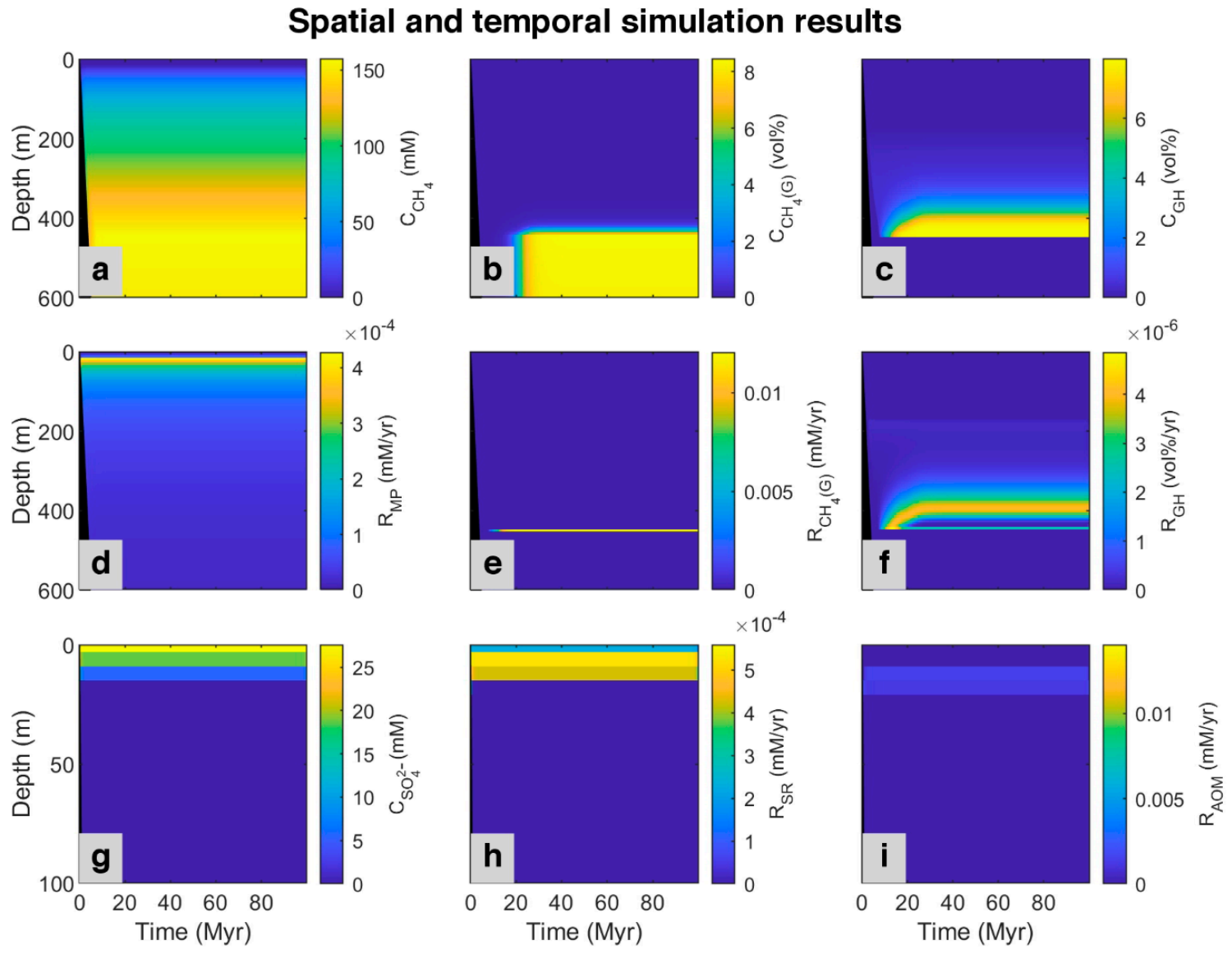
References
- Hu, Y.; Luo, M.; Chen, L.; Liang, Q.; Feng, D.; Tao, J.; Yang, S.; Chen, D. Methane source linked to gas hydrate system at hydrate drilling areas of the South China Sea: Porewater geochemistry and numerical model constraints. J. Asian Earth Sci. 2018, 168, 87–95. [Google Scholar] [CrossRef]
- Buffett, B.; Archer, D. Global inventory of methane clathrate: Sensitivity to changes in the deep ocean. Earth Planet. Sci. Lett. 2004, 227, 185–199. [Google Scholar] [CrossRef]
- Kvenvolden, K.A. Gas hydrates—Geological perspective and global change. Rev. Geophys. 1993, 31, 173–187. [Google Scholar] [CrossRef]
- Regnier, P.; Dale, A.W.; Arndt, S.; LaRowe, D.E.; Mogollón, J.; Van Cappellen, P. Quantitative analysis of anaerobic oxidation of methane (AOM) in marine sediments: A modeling perspective. Earth-Sci. Rev. 2011, 106, 105–130. [Google Scholar] [CrossRef]
- Berner, R.A. Atmospheric Carbon Dioxide Levels Over Phanerozoic Time. Science 1990, 249, 1382–1386. [Google Scholar] [CrossRef] [PubMed]
- Dale, A.W.; Flury, S.; Fossing, H.; Regnier, P.; Røy, H.; Scholze, C.; Jørgensen, B.B. Kinetics of organic carbon mineralization and methane formation in marine sediments (Aarhus Bay, Denmark). Geochim. Cosmochim. Acta 2019, 252, 159–178. [Google Scholar] [CrossRef]
- Arndt, S.; Jørgensen, B.B.; LaRowe, D.E.; Middelburg, J.J.; Pancost, R.D.; Regnier, P. Quantifying the degradation of organic matter in marine sediments: A review and synthesis. Earth-Sci. Rev. 2013, 123, 53–86. [Google Scholar] [CrossRef]
- Middelburg, J.J. A simple rate model for organic matter decomposition in marine sediments. Geochim. Cosmochim. Acta 1989, 53, 1577–1581. [Google Scholar] [CrossRef]
- Wallmann, K.; Aloisi, G.; Haeckel, M.; Obzhirov, A.; Pavlova, G.; Tishchenko, P. Kinetics of organic matter degradation, microbial methane generation, and gas hydrate formation in anoxic marine sediments. Geochim. Cosmochim. Acta 2006, 70, 3905–3927. [Google Scholar] [CrossRef]
- Demirbas, A. Methane hydrates as potential energy resource: Part 1—Importance, resource and recovery facilities. Energy Convers. Manag. 2010, 51, 1547–1561. [Google Scholar] [CrossRef]
- de Garidel-Thoron, T.; Beaufort, L.; Bassinot, F.; Henry, P. Evidence for large methane releases to the atmosphere from deep-sea gas-hydrate dissociation during the last glacial episode. Proc. Natl. Acad. Sci. USA 2004, 101, 9187–9192. [Google Scholar] [CrossRef] [Green Version]
- Ruppel, C.D.; Kessler, J.D. The interaction of climate change and methane hydrates. Rev. Geophys. 2017, 55, 126–168. [Google Scholar] [CrossRef]
- Tinivella, U.; Giustiniani, M.; Vargas Cordero, I.D.L.C.; Vasilev, A. Gas Hydrate: Environmental and Climate Impacts. Geosciences 2019, 9, 443. [Google Scholar] [CrossRef] [Green Version]
- Piñero, E.; Marquardt, M.; Hensen, C.; Haeckel, M.; Wallmann, K. Estimation of the global inventory of methane hydrates in marine sediments using transfer functions. Biogeosciences 2013, 10, 959–975. [Google Scholar] [CrossRef] [Green Version]
- Wallmann, K.; Pinero, E.; Burwicz, E.; Haeckel, M.; Hensen, C.; Dale, A.; Ruepke, L. The Global Inventory of Methane Hydrate in Marine Sediments: A Theoretical Approach. Energies 2012, 5, 2449–2498. [Google Scholar] [CrossRef]
- Dickens, G.R.; Paull, C.K.; Wallace, P. Direct measurement of in situ methane quantities in a large gas-hydrate reservoir. Nature 1997, 385, 426–428. [Google Scholar] [CrossRef] [Green Version]
- Kvenvolden, K.A.; Lorenson, T.D. The Global Occurrence of Natural Gas Hydrate. Nat. Gas. Hydrates Occur. Distrib. Detect. 2001, 124, 3–18. [Google Scholar]
- Zhang, Y.; Luo, M.; Hu, Y.; Wang, H.; Chen, D. An Areal Assessment of Subseafloor Carbon Cycling in Cold Seeps and Hydrate-Bearing Areas in the Northern South China Sea. Geofluid 2019, 2019, 2573937. [Google Scholar] [CrossRef]
- Wallmann, K.; Riedel, M.; Hong, W.L.; Patton, H.; Hubbard, A.; Pape, T.; Hsu, C.W.; Schmidt, C.; Johnson, J.E.; Torres, M.E.; et al. Gas hydrate dissociation off Svalbard induced by isostatic rebound rather than global warming. Nat. Commun. 2018, 9, 83. [Google Scholar] [CrossRef]
- Zhu, H.; Xu, T.; Zhu, Z.; Yuan, Y.; Tian, H. Numerical modeling of methane hydrate accumulation with mixed sources in marine sediments: Case study of Shenhu Area, South China Sea. Mar. Geol. 2020, 423, 106142. [Google Scholar] [CrossRef]
- Malinverno, A. Marine gas hydrates in thin sand layers that soak up microbial methane. Earth Planet. Sci. Lett. 2010, 292, 399–408. [Google Scholar] [CrossRef]
- Egeberg, P.K.; Dickens, G.R. Thermodynamic and pore water halogen constraints on gas hydrate distribution at ODP Site 997 (Blake Ridge). Chem. Geol. 1999, 153, 53–79. [Google Scholar] [CrossRef]
- Zatsepina, O.Y.; Buffett, B.A. Phase equilibrium of gas hydrate: Implications for the formation of hydrate in the deep sea floor. Geophys. Res. Lett. 1997, 24, 1567–1570. [Google Scholar] [CrossRef]
- Sloan, E., Jr.; Koh, C.A. Clathrate Hydrates of Natural Gases, 3rd ed.; CRC Press: Boca Raton, FL, USA, 2008. [Google Scholar]
- Burwicz, E.; Rüpke, L. Thermal State of the Blake Ridge Gas Hydrate Stability Zone (GHSZ)—Insights on Gas Hydrate Dynamics from a New Multi-Phase Numerical Model. Energies 2019, 12, 3403. [Google Scholar] [CrossRef] [Green Version]
- Skarke, A.; Ruppel, C.; Kodis, M.; Brothers, D.; Lobecker, E. Widespread methane leakage from the sea floor on the northern US Atlantic margin. Nat. Geosci. 2014, 7, 657–661. [Google Scholar] [CrossRef]
- Petersen, C.J.; Bünz, S.; Hustoft, S.; Mienert, J.; Klaeschen, D. High-resolution P-Cable 3D seismic imaging of gas chimney structures in gas hydrated sediments of an Arctic sediment drift. Mar. Pet. Geol. 2010, 27, 1981–1994. [Google Scholar] [CrossRef]
- Bünz, S.; Polyanov, S.; Vadakkepuliyambatta, S.; Consolaro, C.; Mienert, J. Active gas venting through hydrate-bearing sediments on the Vestnesa Ridge, offshore W-Svalbard. Mar. Geol. 2012, 332–334, 189–197. [Google Scholar] [CrossRef]
- Gorman, A.R.; Holbrook, W.S.; Hornbach, M.J.; Hackwith, K.L.; Lizarralde, D.; Pecher, I. Migration of methane gas through the hydrate stability zone in a low-flux hydrate province. Geology 2002, 30, 327–330. [Google Scholar] [CrossRef]
- Wood, W.T.; Gettrust, J.F.; Chapman, N.R.; Spence, G.D.; Hyndman, R.D. Decreased stability of methane hydrates in marine sediments owing to phase-boundary roughness. Nature 2002, 420, 656–660. [Google Scholar] [CrossRef]
- Tréhu, A.M.; Flemings, P.B.; Bangs, N.L.; Chevallier, J.; Gràcia, E.; Johnson, J.E.; Liu, C.-S.; Liu, X.; Riedel, M.; Torres, M.E. Feeding methane vents and gas hydrate deposits at south Hydrate Ridge. Geophys. Res. Lett. 2004, 31. [Google Scholar] [CrossRef] [Green Version]
- Linke, P.; Suess, E.; Torres, M.; Martens, V.; Rugh, W.D.; Ziebis, W.; Kulm, L.D. In situ measurement of fluid flow from cold seeps at active continental margins. Deep Sea Res. Part I Oceanogr. Res. Pap. 1994, 41, 721–739. [Google Scholar] [CrossRef] [Green Version]
- Suess, E.; Torres, M.E.; Bohrmann, G.; Collier, R.W.; Greinert, J.; Linke, P.; Rehder, G.; Trehu, A.; Wallmann, K.; Winckler, G.; et al. Gas hydrate destabilization: Enhanced dewatering, benthic material turnover and large methane plumes at the Cascadia convergent margin. Earth Planet. Sci. Lett. 1999, 170, 1–15. [Google Scholar] [CrossRef]
- Ketzer, M.; Praeg, D.; Rodrigues, L.F.; Augustin, A.; Pivel, M.A.G.; Rahmati-Abkenar, M.; Miller, D.J.; Viana, A.R.; Cupertino, J.A. Gas hydrate dissociation linked to contemporary ocean warming in the southern hemisphere. Nat. Commun. 2020, 11, 3788. [Google Scholar] [CrossRef]
- Pecher, I.A.; Villinger, H.; Kaul, N.; Crutchley, G.J.; Mountjoy, J.J.; Huhn, K.; Kukowski, N.; Henrys, S.A.; Rose, P.S.; Coffin, R.B. A Fluid Pulse on the Hikurangi Subduction Margin: Evidence from a Heat Flux Transect across the Upper Limit of Gas Hydrate Stability. Geophys. Res. Lett. 2017, 44, 12312–385395. [Google Scholar] [CrossRef] [Green Version]
- Liu, X.; Flemings, P.B. Passing gas through the hydrate stability zone at southern Hydrate Ridge, offshore Oregon. Earth Planet. Sci. Lett. 2006, 241, 211–226. [Google Scholar] [CrossRef]
- Liu, X.; Flemings, P.B. Capillary effects on hydrate stability in marine sediments. J. Geophys. Res. Solid Earth 2011, 116. [Google Scholar] [CrossRef]
- Fu, X.; Jimenez-Martinez, J.; Nguyen, T.P.; Carey, J.W.; Viswanathan, H.; Cueto-Felgueroso, L.; Juanes, R. Crustal fingering facilitates free-gas methane migration through the hydrate stability zone. Proc. Natl. Acad. Sci. USA 2020, 117, 31660–31664. [Google Scholar] [CrossRef] [PubMed]
- Luff, R.; Wallmann, K. Fluid flow, methane fluxes, carbonate precipitation and biogeochemical turnover in gas hydrate-bearing sediments at Hydrate Ridge, Cascadia Margin: Numerical modeling and mass balances. Geochim. Cosmochim. Acta 2003, 67, 3403–3421. [Google Scholar] [CrossRef]
- Haacke, R.R.; Westbrook, G.K.; Hyndman, R.D. Gas hydrate, fluid flow and free gas: Formation of the bottom-simulating reflector. Earth Planet. Sci. Lett. 2007, 261, 407–420. [Google Scholar] [CrossRef]
- Chuang, P.-C.; Young, M.B.; Dale, A.W.; Miller, L.G.; Herrera-Silveira, J.A.; Paytan, A. Methane and sulfate dynamics in sediments from mangrove-dominated tropical coastal lagoons, Yucatán, Mexico. Biogeosciences 2016, 13, 2981–3001. [Google Scholar] [CrossRef] [Green Version]
- Puglini, M.; Brovkin, V.; Regnier, P.; Arndt, S. Assessing the potential for non-turbulent methane escape from the East Siberian Arctic Shelf. Biogeosciences 2020, 17, 3247–3275. [Google Scholar] [CrossRef]
- Tian, H.; Yu, C.; Xu, T.; Liu, C.; Jia, W.; Li, Y.; Shang, S. Combining reactive transport modeling with geochemical observations to estimate the natural gas hydrate accumulation. Appl. Energy 2020, 275, 115362. [Google Scholar] [CrossRef]
- Gupta, S.; Wohlmuth, B.; Haeckel, M. An All-At-Once Newton Strategy for Marine Methane Hydrate Reservoir Models. Energies 2020, 13, 503. [Google Scholar] [CrossRef] [Green Version]
- Tucholke, B.E.; Bryan, G.M.; Ewing, J.I. Gas-Hydrate Horizons Detected in Seismic-Profiler Data from the Western North Atlantic. Am. Assoc. Pet. Geol. Bull. 1977, 61, 698–707. [Google Scholar] [CrossRef]
- Borowski, W.S.; Paull, C.K.; Ussler, W. Carbon cycling within the upper methanogenic zone of continental rise sediments; An example from the methane-rich sediments overlying the Blake Ridge gas hydrate deposits. Mar. Chem. 1997, 57, 299–311. [Google Scholar] [CrossRef]
- Holbrook, W.S. Seismic Studies of the Blake Ridge: Implications for Hydrate Distribution, Methane Expulsion, and Free Gas Dynamics. Nat. Gas. Hydrates Occur. Distrib. Detect. 2001, 124, 235–256. [Google Scholar]
- Fehn, U.; Snyder, G.; Egeberg, P.K. Dating of Pore Waters with 129I: Relevance for the Origin of Marine Gas Hydrates. Science 2000, 289, 2332–2335. [Google Scholar] [CrossRef] [PubMed]
- Paull, C.K.; Matsumoto, R.; Wallace, P.J.; Al, E. In Proceedings of the Ocean Drilling Program, Initial Reports, 164, 1996. [CrossRef]
- Berner, R.A. Early Diagenesis; Princeton University Press: Princeton, NJ, USA, 1980; ISBN 9780691082585. [Google Scholar]
- Paull, C.K.; Matsumoto, R.; Wallace, P.J. Shipboard Scientific Party 2 HOLE 997A, 1996. [CrossRef]
- Boudreau, B.P. Diagenetic Models and Their Implementation Modelling Transport and Reactions in Aquatic Sediments; Springer: Berlin/Heidelberg, Germany, 1997; ISBN 97S-3-642-64399-6. [Google Scholar]
- Luff, R.; Wallmann, K.; Grandel, S.; Schlüter, M. Numerical modeling of benthic processes in the deep Arabian Sea. Deep Sea Res. Part II Top. Stud. Oceanogr. 2000, 47, 3039–3072. [Google Scholar] [CrossRef]
- Boudreau, B.P. A Method-of-Lines Code for Carbon and Nutrient Diagenesis in Aquatic Sediments. Comput. Geosci. 1996, 22, 479–496. [Google Scholar] [CrossRef]
- Morad, S.; Ketzer, J.M.; De Ros, L.F. Spatial and temporal distribution of diagenetic alterations in siliciclastic rocks: Implications for mass transfer in sedimentary basins. Sedimentology 2000, 47, 95–120. [Google Scholar] [CrossRef]
- Paull, C.K.; Matsumoto, R.; Wallace, P.J. Site 997. Shipboard Scientific Party, 1996. [Google Scholar] [CrossRef]
- Davie, M.K.; Buffett, B.A. A numerical model for the formation of gas hydrate below the seafloor. J. Geophys. Res. Solid Earth 2001, 106, 497–514. [Google Scholar] [CrossRef]
- Rassmann, J.; Lansard, B.; Pozzato, L.; Rabouille, C. Carbonate chemistry in sediment porewaters of the Rhône River delta driven by early diagenesis (northwestern Mediterranean). Biogeosciences 2016, 13, 5379–5394. [Google Scholar] [CrossRef] [Green Version]
- Wiseman, J.D.H. Calcium and magnesium carbonate in some indian ocean sediments. Prog. Oceanogr. 1965, 3, 373–383. [Google Scholar] [CrossRef]
- Zheng, Z.; Cao, Y.; Xu, W.; Chen, D. A Numerical Model to Estimate the Effects of Variable Sedimentation Rates on Methane Hydrate Formation—Application to the ODP Site 997 on Blake Ridge, Southeastern North American Continental Margin. J. Geophys. Res. Solid Earth 2020, 125, e2019JB018851. [Google Scholar] [CrossRef]
- Xu, S.; Fan, S.; Fang, S.; Lang, X.; Wang, Y.; Chen, J. Pectin as an Extraordinary Natural Kinetic Hydrate Inhibitor. Sci. Rep. 2016, 6, 23220. [Google Scholar] [CrossRef]
- Mangiacapra, P.; Gorrasi, G.; Sorrentino, A.; Vittoria, V. Biodegradable nanocomposites obtained by ball milling of pectin and montmorillonites. Carbohydr. Polym. 2006, 64, 516–523. [Google Scholar] [CrossRef]
- Liu, J.; Feng, Y.; Yan, Y.; Yan, Y.; Zhang, J. Understanding the inhibition performance of polyvinylcaprolactam and interactions with water molecules. Chem. Phys. Lett. 2020, 761, 138070. [Google Scholar] [CrossRef]
- Lorenson, T.D.; Colwell, F.S.; Delwiche, M.; Dougherty, J.A. Data report: Acetate and hydrogen concentrations in pore fluids associated with a large gas hydrate reservoir, southern Hydrate Ridge, offshore Oregon, USA. Proc. Ocean. Drill. Progr. Sci. Results 2005, 204. [Google Scholar] [CrossRef] [Green Version]
- Millero, F. CHAPTER 43—Influence of Pressure on Chemical Processes in the Sea; Academic Press: Cambridge, MA, USA, 1983. [Google Scholar]
- Millero, F.J. Thermodynamics of the carbon dioxide system in the oceans. Geochim. Cosmochim. Acta 1995, 59, 661–677. [Google Scholar] [CrossRef]
- Li, J.; Li, X. Numerical Modeling of CO2, Water, Sodium Chloride, and Magnesium Carbonates Equilibrium to High Temperature and Pressure. Energies 2019, 12, 4533. [Google Scholar] [CrossRef] [Green Version]
- Tishchenko, P.; Hensen, C.; Wallmann, K.; Wong, C.S. Calculation of the stability and solubility of methane hydrate in seawater. Chem. Geol. 2005, 219, 37–52. [Google Scholar] [CrossRef]
- Duan, Z.; Mao, S. A thermodynamic model for calculating methane solubility, density and gas phase composition of methane-bearing aqueous fluids from 273 to 523 K and from 1 to 2000 bar. Geochim. Cosmochim. Acta 2006, 70, 3369–3386. [Google Scholar] [CrossRef]
- Duan, Z.; Møller, N.; Greenberg, J.; Weare, J.H. The prediction of methane solubility in natural waters to high ionic strength from 0 to 250 °C and from 0 to 1600 bar. Geochim. Cosmochim. Acta 1992, 56, 1451–1460. [Google Scholar] [CrossRef]
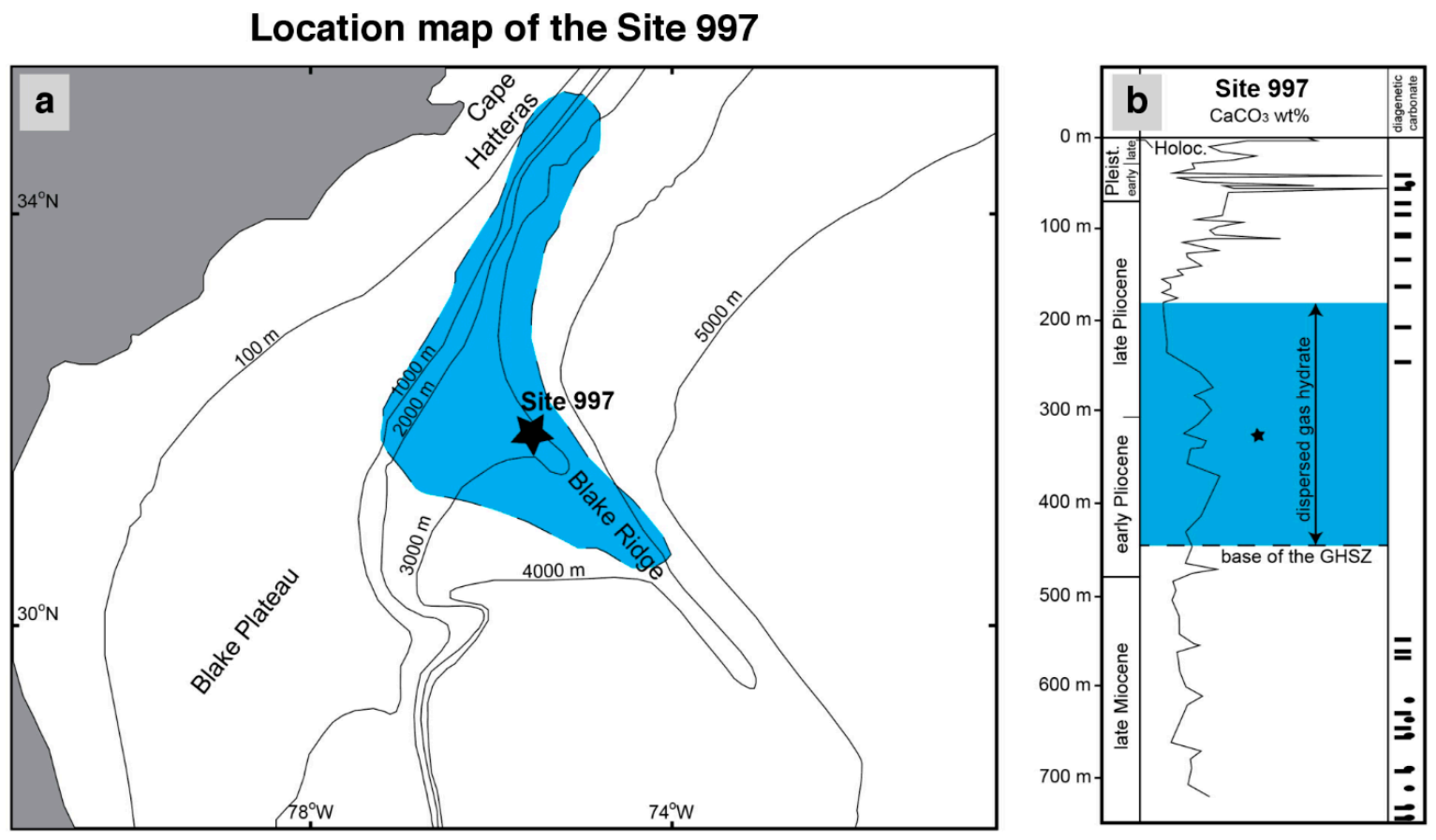
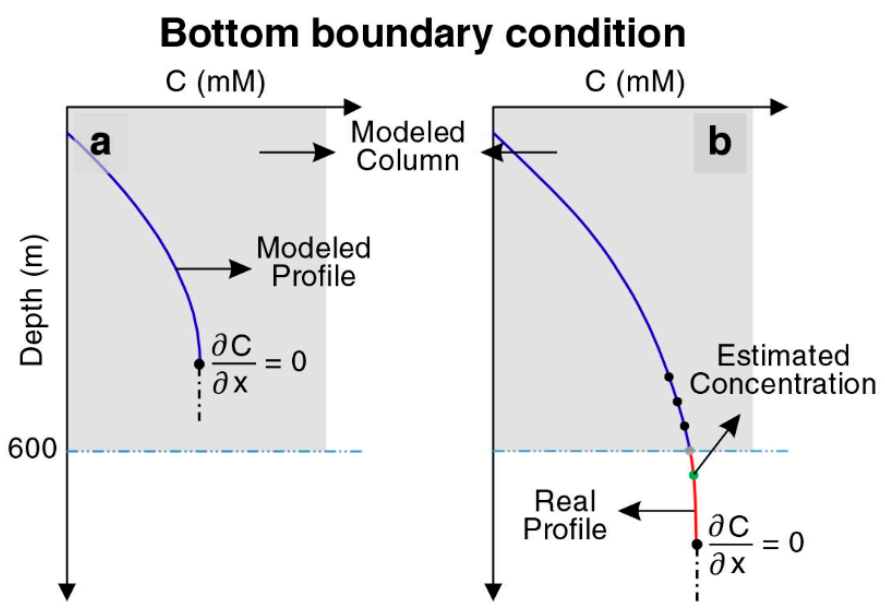
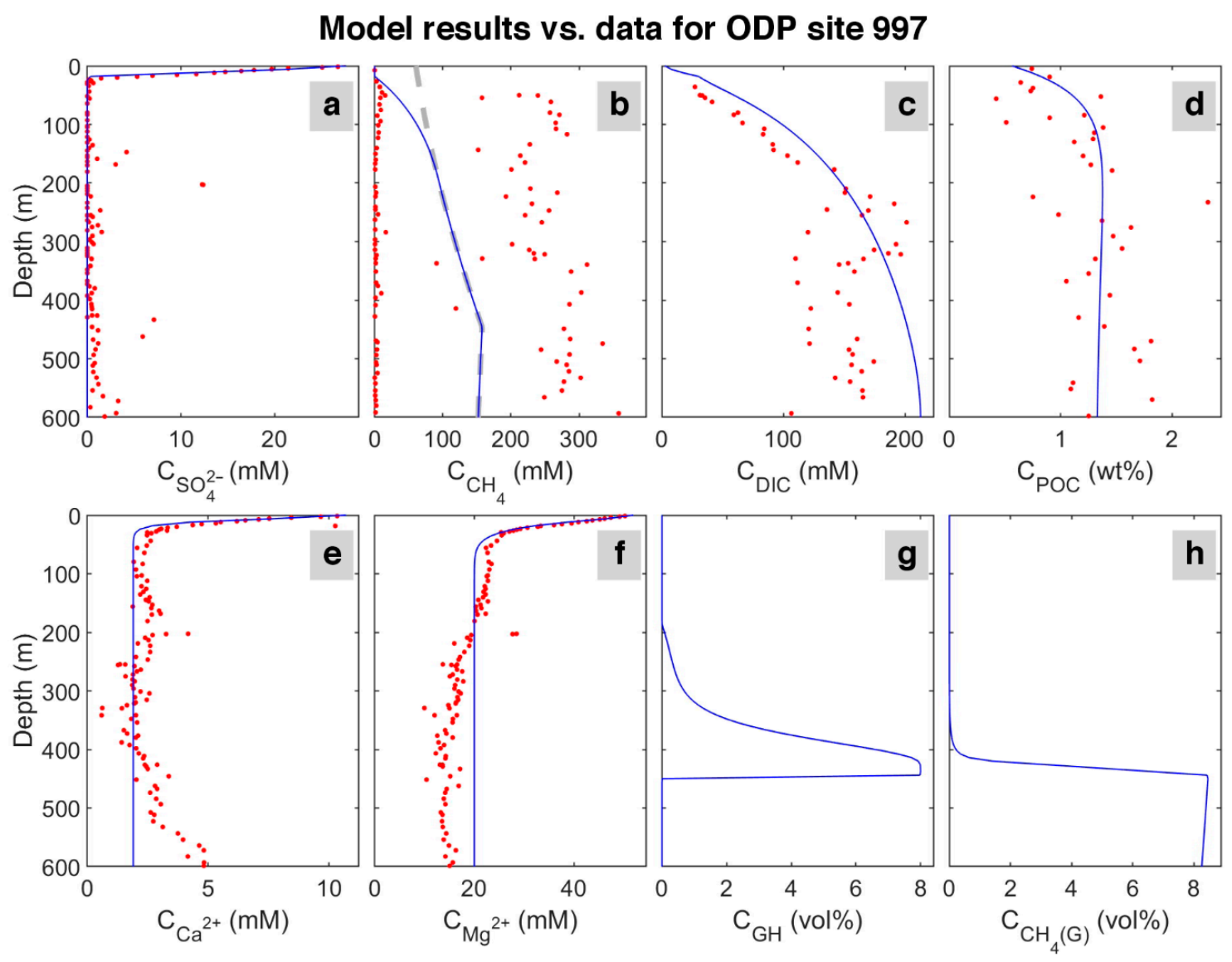

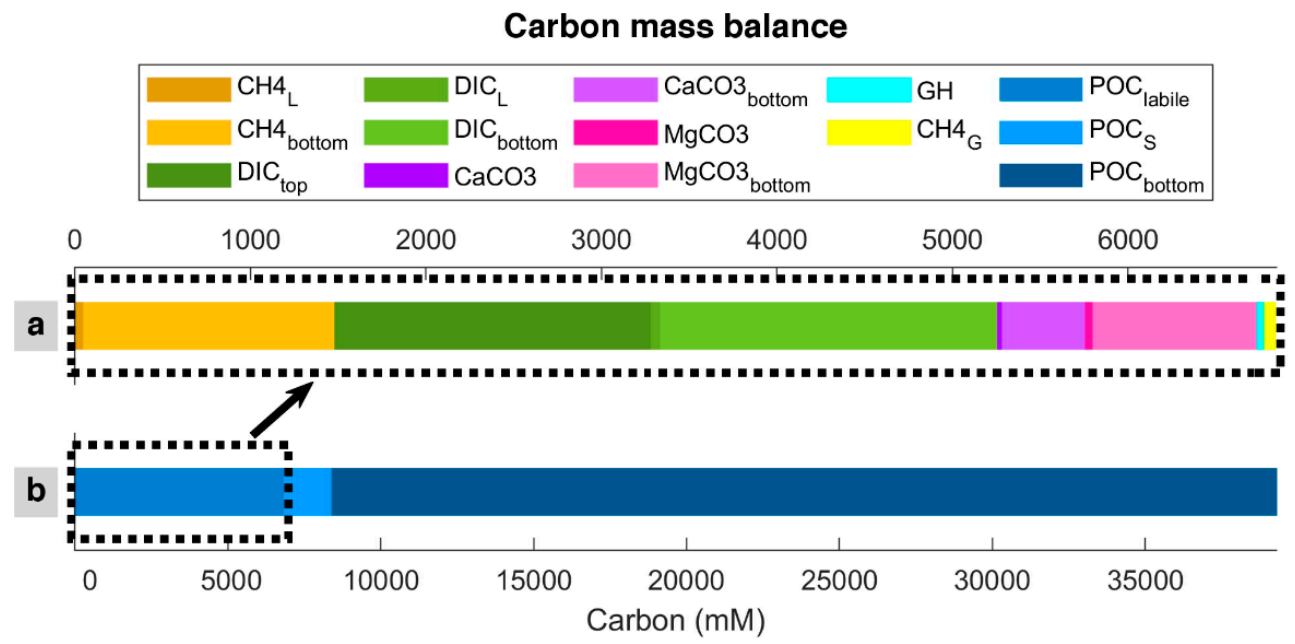
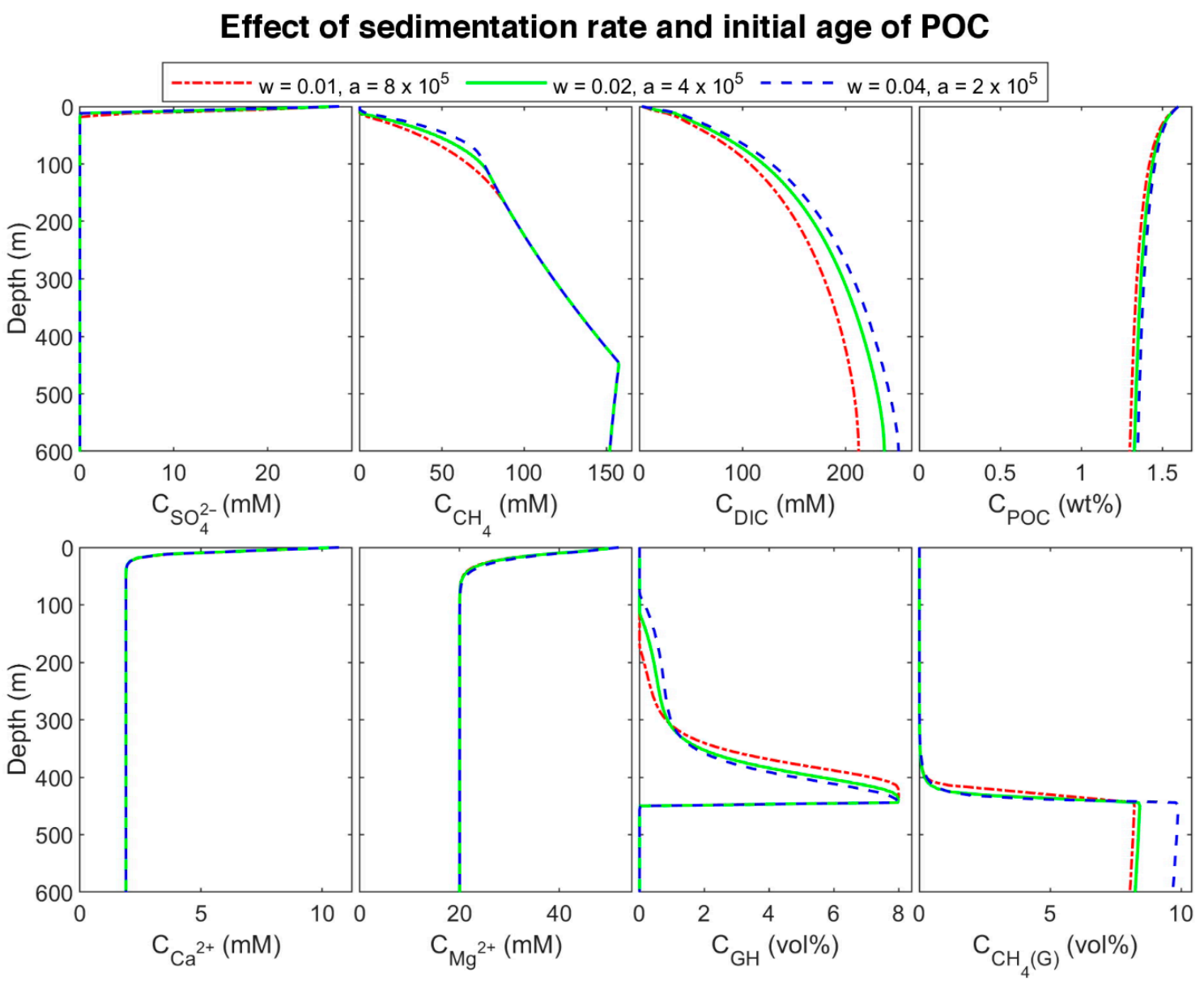


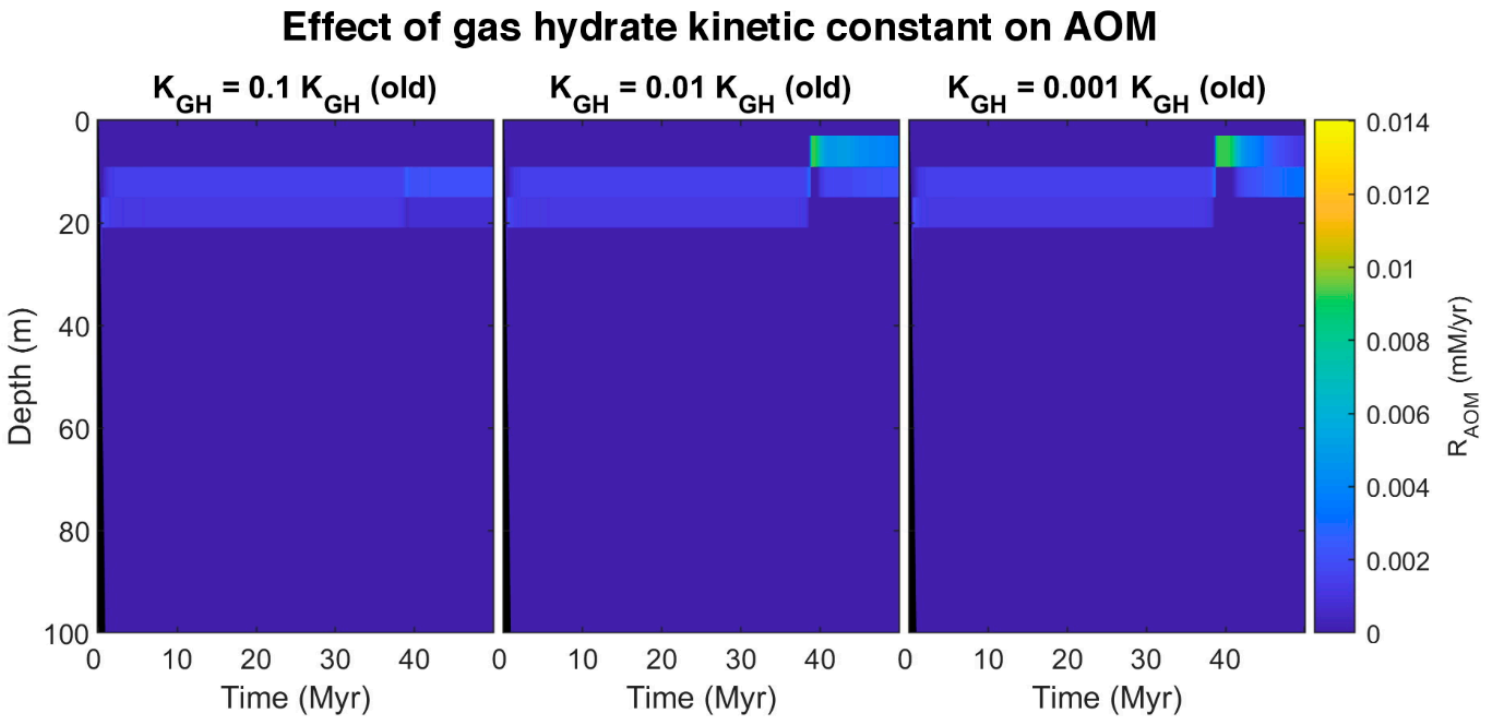
Publisher’s Note: MDPI stays neutral with regard to jurisdictional claims in published maps and institutional affiliations. |
© 2021 by the authors. Licensee MDPI, Basel, Switzerland. This article is an open access article distributed under the terms and conditions of the Creative Commons Attribution (CC BY) license (https://creativecommons.org/licenses/by/4.0/).
Share and Cite
Rahmati-Abkenar, M.; Alizadeh, M.; Ketzer, M. A New Dynamic Modeling Approach to Predict Microbial Methane Generation and Consumption in Marine Sediments. Energies 2021, 14, 5671. https://doi.org/10.3390/en14185671
Rahmati-Abkenar M, Alizadeh M, Ketzer M. A New Dynamic Modeling Approach to Predict Microbial Methane Generation and Consumption in Marine Sediments. Energies. 2021; 14(18):5671. https://doi.org/10.3390/en14185671
Chicago/Turabian StyleRahmati-Abkenar, Mahboubeh, Milad Alizadeh, and Marcelo Ketzer. 2021. "A New Dynamic Modeling Approach to Predict Microbial Methane Generation and Consumption in Marine Sediments" Energies 14, no. 18: 5671. https://doi.org/10.3390/en14185671






